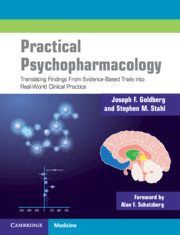 Practical Psychopharmacology
Practical Psychopharmacology from Part I - General Principles
Published online by Cambridge University Press: 19 October 2021
When investigators report the findings from a clinical trial, the results require interpretation. Peer review is the process through which the structure and execution of a clinical study is judged to be coherent, linear, and logical. The procedure is not unlike conducting a mental status exam: the evaluator is trying to discern if the content is credible at face value, if any underlying factors that could be biasing the results are accounted for, if the observed phenomena are being interpreted accurately, and if the conclusions drawn are valid. With varying degrees of provisionality or certainty, clinical trials give information about the narrow impact of (usually) one intervention versus a comparator (a placebo; an active comparator; or treatment as usual (TAU)) for a circumscribed period of time, with efforts made to hold other relevant variables constant (so, no other treatments are begun or altered, adherence must be near-perfect, substance use is grounds for ejection, and major life disruptions could botch the findings).
To save this book to your Kindle, first ensure [email protected] is added to your Approved Personal Document E-mail List under your Personal Document Settings on the Manage Your Content and Devices page of your Amazon account. Then enter the ‘name’ part of your Kindle email address below. Find out more about saving to your Kindle.
Note you can select to save to either the @free.kindle.com or @kindle.com variations. ‘@free.kindle.com’ emails are free but can only be saved to your device when it is connected to wi-fi. ‘@kindle.com’ emails can be delivered even when you are not connected to wi-fi, but note that service fees apply.
Find out more about the Kindle Personal Document Service.
To save content items to your account, please confirm that you agree to abide by our usage policies. If this is the first time you use this feature, you will be asked to authorise Cambridge Core to connect with your account. Find out more about saving content to Dropbox.
To save content items to your account, please confirm that you agree to abide by our usage policies. If this is the first time you use this feature, you will be asked to authorise Cambridge Core to connect with your account. Find out more about saving content to Google Drive.